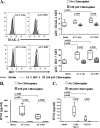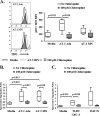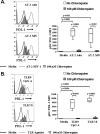Chloroquine modulates HIV-1-induced plasmacytoid dendritic cell alpha interferon: implication for T-cell activation
- PMID: 19949061
- PMCID: PMC2812138
- DOI: 10.1128/AAC.01246-09
Chloroquine modulates HIV-1-induced plasmacytoid dendritic cell alpha interferon: implication for T-cell activation
Abstract
Plasmacytoid dendritic cells (pDC) contribute to antiviral immunity mainly through recognition of microbial products and viruses via intracellular Toll-like receptor 7 (TLR7) or TLR9, resulting in the production of type I interferons (IFNs). Although interferons reduce the viral burden in the acute phase of infection, their role in the chronic phase is unclear. The presence of elevated plasma IFN-alpha levels in advanced HIV disease and its association with microbial translocation in chronic HIV infection lead us to hypothesize that IFN-alpha could contribute to immune activation. Blocking of IFN-alpha production using chloroquine, an endosomal inhibitor, was tested in a novel in vitro model system with the aim of characterizing the effects of chloroquine on HIV-1-mediated TLR signaling, IFN-alpha production, and T-cell activation. Our results indicate that chloroquine blocks TLR-mediated activation of pDC and MyD88 signaling, as shown by decreases in the levels of the downstream signaling molecules IRAK-4 and IRF-7 and by inhibition of IFN-alpha synthesis. Chloroquine decreased CD8 T-cell activation induced by aldrithiol-2-treated HIV-1 in peripheral blood mononuclear cell cultures. In addition to blocking pDC activation, chloroquine also blocked negative modulators of the T-cell response, such as indoleamine 2,3-dioxygenase (IDO) and programmed death ligand 1 (PDL-1). Our results indicate that TLR stimulation and production of IFN-alpha by pDC contribute to immune activation and that blocking of these pathways using chloroquine may interfere with events contributing to HIV pathogenesis. Our results suggests that a safe, well-tolerated drug such as chloroquine can be proposed as an adjuvant therapeutic candidate along with highly active antiretroviral therapy to control immune activation in HIV-1 infection.
Figures





Similar articles
-
Toll-like receptor 7-adapter complex modulates interferon-α production in HIV-stimulated plasmacytoid dendritic cells.PLoS One. 2019 Dec 12;14(12):e0225806. doi: 10.1371/journal.pone.0225806. eCollection 2019. PLoS One. 2019. PMID: 31830058 Free PMC article.
-
Blocking TLR7- and TLR9-mediated IFN-α production by plasmacytoid dendritic cells does not diminish immune activation in early SIV infection.PLoS Pathog. 2013;9(7):e1003530. doi: 10.1371/journal.ppat.1003530. Epub 2013 Jul 25. PLoS Pathog. 2013. PMID: 23935491 Free PMC article.
-
HIV turns plasmacytoid dendritic cells (pDC) into TRAIL-expressing killer pDC and down-regulates HIV coreceptors by Toll-like receptor 7-induced IFN-alpha.Proc Natl Acad Sci U S A. 2007 Oct 30;104(44):17453-8. doi: 10.1073/pnas.0707244104. Epub 2007 Oct 23. Proc Natl Acad Sci U S A. 2007. PMID: 17956986 Free PMC article.
-
Sex Differences in Primary HIV Infection: Revisiting the Role of TLR7-Driven Type 1 IFN Production by Plasmacytoid Dendritic Cells in Women.Front Immunol. 2021 Aug 27;12:729233. doi: 10.3389/fimmu.2021.729233. eCollection 2021. Front Immunol. 2021. PMID: 34512664 Free PMC article. Review.
-
HIV-1 infection and induction of interferon alpha in plasmacytoid dendritic cells.Curr Opin HIV AIDS. 2011 Sep;6(5):373-8. doi: 10.1097/COH.0b013e328349592a. Curr Opin HIV AIDS. 2011. PMID: 21734568 Review.
Cited by
-
Elucidating the Pivotal Immunomodulatory and Anti-Inflammatory Potentials of Chloroquine and Hydroxychloroquine.J Immunol Res. 2020 Sep 25;2020:4582612. doi: 10.1155/2020/4582612. eCollection 2020. J Immunol Res. 2020. PMID: 33062720 Free PMC article. Review.
-
Influence of quinacrine and chloroquine on the in vitro 3'-azido-3'-deoxythymidine antiretroviral effect.AIDS Res Ther. 2015 Mar 19;12:7. doi: 10.1186/s12981-015-0048-9. eCollection 2015. AIDS Res Ther. 2015. PMID: 25788967 Free PMC article.
-
Downregulation of TLR7/9 leads to deficient production of IFN-α from plasmacytoid dendritic cells in chronic hepatitis B.Inflamm Res. 2012 Sep;61(9):997-1004. doi: 10.1007/s00011-012-0493-z. Epub 2012 Jun 10. Inflamm Res. 2012. PMID: 22684144
-
HIV-1 Tat protein induces the production of IDO in human monocyte derived-dendritic cells through a direct mechanism: effect on T cells proliferation.PLoS One. 2013 Sep 20;8(9):e74551. doi: 10.1371/journal.pone.0074551. eCollection 2013. PLoS One. 2013. PMID: 24073214 Free PMC article.
-
Activating autophagy to potentiate immunogenic chemotherapy and radiation therapy.Nat Rev Clin Oncol. 2017 Apr;14(4):247-258. doi: 10.1038/nrclinonc.2016.183. Epub 2016 Nov 15. Nat Rev Clin Oncol. 2017. PMID: 27845767 Review.
References
-
- Abe, M., Z. Wang, A. de Creus, and A. W. Thomson. 2005. Plasmacytoid dendritic cell precursors induce allogeneic T-cell hyporesponsiveness and prolong heart graft survival. Am. J. Transplant. 5:1808-1819. - PubMed
-
- Akira, S., K. Takeda, and T. Kaisho. 2001. Toll-like receptors: critical proteins linking innate and acquired immunity. Nat. Immunol. 2:675-680. - PubMed
-
- Almeida, M., M. Cordero, J. Almeida, and A. Orfao. 2005. Different subsets of peripheral blood dendritic cells show distinct phenotypic and functional abnormalities in HIV-1 infection. AIDS 19:261-271. - PubMed
-
- Andersson, J., A. Boasso, J. Nilsson, R. Zhang, N. J. Shire, S. Lindback, G. M. Shearer, and C. A. Chougnet. 2005. The prevalence of regulatory T cells in lymphoid tissue is correlated with viral load in HIV-infected patients. J. Immunol. 174:3143-3147. - PubMed
MeSH terms
Substances
LinkOut - more resources
Full Text Sources
Other Literature Sources
Medical
Research Materials

